Iterative and Agile System Development Methodologies for AFD's Information System
VerifiedAdded on 2023/06/11
|10
|3055
|335
AI Summary
This report discusses various iterative and agile system development methodologies that can be used for designing and developing the proposed information system for AFD, an Australian business that sells woman garments to the retail stores and to individual customers. The report covers SCRUM, RAD, XP, and Iterative Model. It also provides a recommendation for AFD to follow the SCRUM approach. The memo discusses the integration of UCD and HCI for the proposed information system. The event table, domain model class diagram, and design class diagram are also included in the report.
Contribute Materials
Your contribution can guide someone’s learning journey. Share your
documents today.
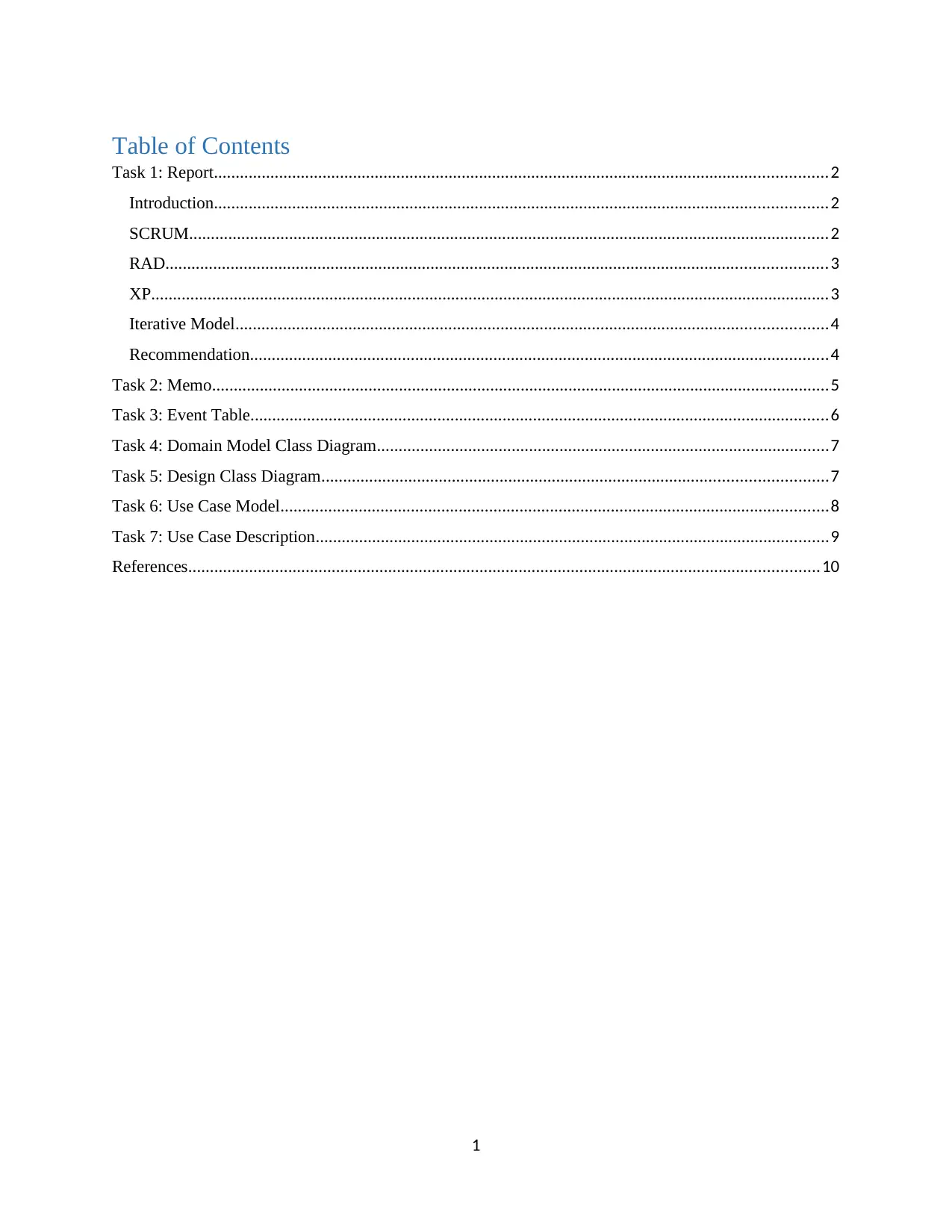
Table of Contents
Task 1: Report.............................................................................................................................................2
Introduction.............................................................................................................................................2
SCRUM...................................................................................................................................................2
RAD........................................................................................................................................................3
XP............................................................................................................................................................3
Iterative Model........................................................................................................................................4
Recommendation.....................................................................................................................................4
Task 2: Memo..............................................................................................................................................5
Task 3: Event Table.....................................................................................................................................6
Task 4: Domain Model Class Diagram........................................................................................................7
Task 5: Design Class Diagram....................................................................................................................7
Task 6: Use Case Model..............................................................................................................................8
Task 7: Use Case Description......................................................................................................................9
References.................................................................................................................................................10
1
Task 1: Report.............................................................................................................................................2
Introduction.............................................................................................................................................2
SCRUM...................................................................................................................................................2
RAD........................................................................................................................................................3
XP............................................................................................................................................................3
Iterative Model........................................................................................................................................4
Recommendation.....................................................................................................................................4
Task 2: Memo..............................................................................................................................................5
Task 3: Event Table.....................................................................................................................................6
Task 4: Domain Model Class Diagram........................................................................................................7
Task 5: Design Class Diagram....................................................................................................................7
Task 6: Use Case Model..............................................................................................................................8
Task 7: Use Case Description......................................................................................................................9
References.................................................................................................................................................10
1
Secure Best Marks with AI Grader
Need help grading? Try our AI Grader for instant feedback on your assignments.

Task 1: Report
Introduction
AFD is an Australian business that sells woman garments to the retail stores and to individual customers.
They specializes in wedding dresses. So the company has appointed sales representatives who goes to the
retail shops and offers them discounts to make deals. On the other hand, there are wedding representatives
who approaches to individual customers directly to sell wedding dresses. The company uses manual
processes for stock management and customer relationship management also. And it uses some
computerized solutions for emails, communication, and to manage account receivable and payables. As
the business has grown significantly so the manual process has become insufficient to manage the
workload. It is now causing problems like lack of communication, more time spent on minor tasks, issues
with record keeping and business analysis and so on. Hence, the company has decided to implement an
information system that will help to automate the purchase and sales operations of the business.
The scope of the information system is limited within the order taking and processing. But in future, it
will be integrated with other information systems for customer relationship management and so on.
The scope of the report is limited within the discussion on a few iterative and agile system development
methodologies that can be used for designing and developing the proposed information system for the
AFD.
SCRUM
SCRUM is a popular agile software development framework. It is mostly suitable for developing
software. A product owner creates a product backlog containing a prioritized to-do list for the project. On
the other hand, there is a SCRUM master who manages the SCRUM team. SCRUM team members create
sprint backlog that contains decomposed lists of tasks to meet the tasks listed on the product backlog. A
sprint backlog plan is implemented in a sprint or an iteration. The duration of each sprint is kept below 2
weeks. And a cross-functional and small team for SCRUM based project is required (Maximini, 2018).
Each day, there is a brief meeting. These daily standup meetings help to keep track of the jobs being done
by different team members. They also help each other, and share project updates. The product owner also
communicates with other team members to explain and guide then in developing the right system. At the
end of each sprint, again there are review meetings with the stakeholders (James, 2015).
The advantages of SCRUM are,
It is cost effective
It follows divide and conquer process for large projects by diving it into multiple sprints.
During sprint review all developments are coded and tested.
It suitable for fast moving projects.
It offers better visibility among the team members.
It collects information from all stakeholders and allows participation of the end users.
It offers better change management process.
The disadvantages of SCRUM are,
Risk of scope creep.
Sometimes it hard to tell the actual project finish date.
Suitable for experienced team only rather than newbies.
2
Introduction
AFD is an Australian business that sells woman garments to the retail stores and to individual customers.
They specializes in wedding dresses. So the company has appointed sales representatives who goes to the
retail shops and offers them discounts to make deals. On the other hand, there are wedding representatives
who approaches to individual customers directly to sell wedding dresses. The company uses manual
processes for stock management and customer relationship management also. And it uses some
computerized solutions for emails, communication, and to manage account receivable and payables. As
the business has grown significantly so the manual process has become insufficient to manage the
workload. It is now causing problems like lack of communication, more time spent on minor tasks, issues
with record keeping and business analysis and so on. Hence, the company has decided to implement an
information system that will help to automate the purchase and sales operations of the business.
The scope of the information system is limited within the order taking and processing. But in future, it
will be integrated with other information systems for customer relationship management and so on.
The scope of the report is limited within the discussion on a few iterative and agile system development
methodologies that can be used for designing and developing the proposed information system for the
AFD.
SCRUM
SCRUM is a popular agile software development framework. It is mostly suitable for developing
software. A product owner creates a product backlog containing a prioritized to-do list for the project. On
the other hand, there is a SCRUM master who manages the SCRUM team. SCRUM team members create
sprint backlog that contains decomposed lists of tasks to meet the tasks listed on the product backlog. A
sprint backlog plan is implemented in a sprint or an iteration. The duration of each sprint is kept below 2
weeks. And a cross-functional and small team for SCRUM based project is required (Maximini, 2018).
Each day, there is a brief meeting. These daily standup meetings help to keep track of the jobs being done
by different team members. They also help each other, and share project updates. The product owner also
communicates with other team members to explain and guide then in developing the right system. At the
end of each sprint, again there are review meetings with the stakeholders (James, 2015).
The advantages of SCRUM are,
It is cost effective
It follows divide and conquer process for large projects by diving it into multiple sprints.
During sprint review all developments are coded and tested.
It suitable for fast moving projects.
It offers better visibility among the team members.
It collects information from all stakeholders and allows participation of the end users.
It offers better change management process.
The disadvantages of SCRUM are,
Risk of scope creep.
Sometimes it hard to tell the actual project finish date.
Suitable for experienced team only rather than newbies.
2
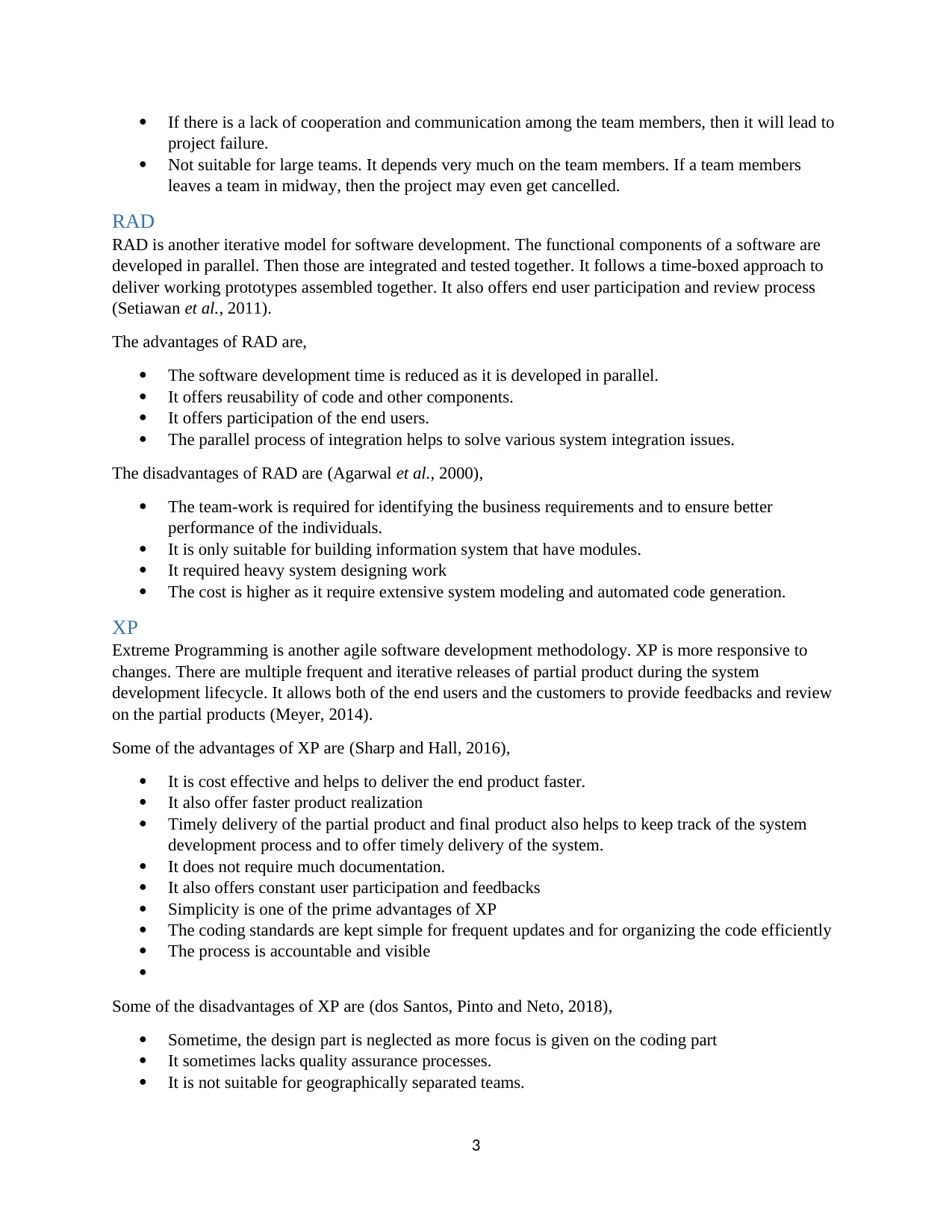
If there is a lack of cooperation and communication among the team members, then it will lead to
project failure.
Not suitable for large teams. It depends very much on the team members. If a team members
leaves a team in midway, then the project may even get cancelled.
RAD
RAD is another iterative model for software development. The functional components of a software are
developed in parallel. Then those are integrated and tested together. It follows a time-boxed approach to
deliver working prototypes assembled together. It also offers end user participation and review process
(Setiawan et al., 2011).
The advantages of RAD are,
The software development time is reduced as it is developed in parallel.
It offers reusability of code and other components.
It offers participation of the end users.
The parallel process of integration helps to solve various system integration issues.
The disadvantages of RAD are (Agarwal et al., 2000),
The team-work is required for identifying the business requirements and to ensure better
performance of the individuals.
It is only suitable for building information system that have modules.
It required heavy system designing work
The cost is higher as it require extensive system modeling and automated code generation.
XP
Extreme Programming is another agile software development methodology. XP is more responsive to
changes. There are multiple frequent and iterative releases of partial product during the system
development lifecycle. It allows both of the end users and the customers to provide feedbacks and review
on the partial products (Meyer, 2014).
Some of the advantages of XP are (Sharp and Hall, 2016),
It is cost effective and helps to deliver the end product faster.
It also offer faster product realization
Timely delivery of the partial product and final product also helps to keep track of the system
development process and to offer timely delivery of the system.
It does not require much documentation.
It also offers constant user participation and feedbacks
Simplicity is one of the prime advantages of XP
The coding standards are kept simple for frequent updates and for organizing the code efficiently
The process is accountable and visible
Some of the disadvantages of XP are (dos Santos, Pinto and Neto, 2018),
Sometime, the design part is neglected as more focus is given on the coding part
It sometimes lacks quality assurance processes.
It is not suitable for geographically separated teams.
3
project failure.
Not suitable for large teams. It depends very much on the team members. If a team members
leaves a team in midway, then the project may even get cancelled.
RAD
RAD is another iterative model for software development. The functional components of a software are
developed in parallel. Then those are integrated and tested together. It follows a time-boxed approach to
deliver working prototypes assembled together. It also offers end user participation and review process
(Setiawan et al., 2011).
The advantages of RAD are,
The software development time is reduced as it is developed in parallel.
It offers reusability of code and other components.
It offers participation of the end users.
The parallel process of integration helps to solve various system integration issues.
The disadvantages of RAD are (Agarwal et al., 2000),
The team-work is required for identifying the business requirements and to ensure better
performance of the individuals.
It is only suitable for building information system that have modules.
It required heavy system designing work
The cost is higher as it require extensive system modeling and automated code generation.
XP
Extreme Programming is another agile software development methodology. XP is more responsive to
changes. There are multiple frequent and iterative releases of partial product during the system
development lifecycle. It allows both of the end users and the customers to provide feedbacks and review
on the partial products (Meyer, 2014).
Some of the advantages of XP are (Sharp and Hall, 2016),
It is cost effective and helps to deliver the end product faster.
It also offer faster product realization
Timely delivery of the partial product and final product also helps to keep track of the system
development process and to offer timely delivery of the system.
It does not require much documentation.
It also offers constant user participation and feedbacks
Simplicity is one of the prime advantages of XP
The coding standards are kept simple for frequent updates and for organizing the code efficiently
The process is accountable and visible
Some of the disadvantages of XP are (dos Santos, Pinto and Neto, 2018),
Sometime, the design part is neglected as more focus is given on the coding part
It sometimes lacks quality assurance processes.
It is not suitable for geographically separated teams.
3
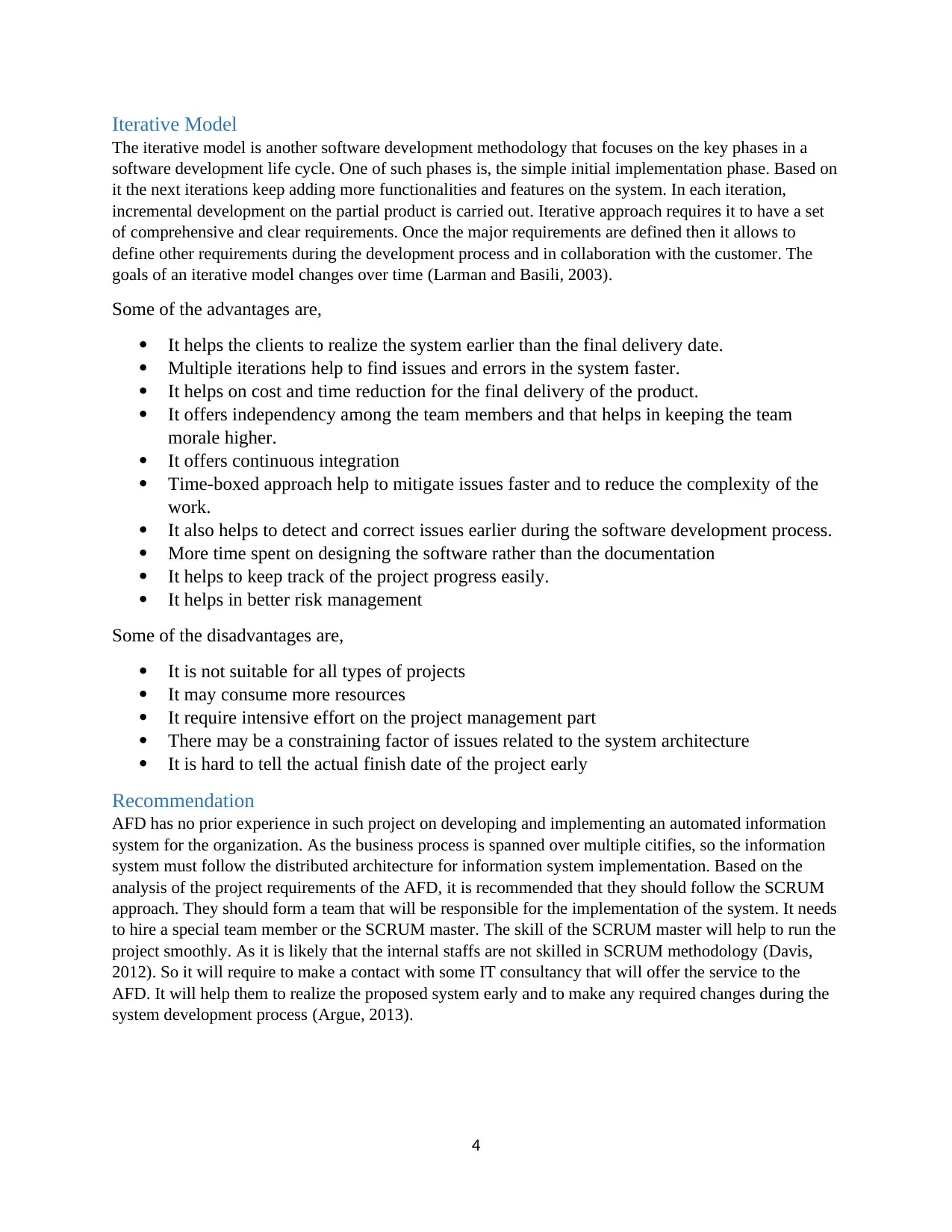
Iterative Model
The iterative model is another software development methodology that focuses on the key phases in a
software development life cycle. One of such phases is, the simple initial implementation phase. Based on
it the next iterations keep adding more functionalities and features on the system. In each iteration,
incremental development on the partial product is carried out. Iterative approach requires it to have a set
of comprehensive and clear requirements. Once the major requirements are defined then it allows to
define other requirements during the development process and in collaboration with the customer. The
goals of an iterative model changes over time (Larman and Basili, 2003).
Some of the advantages are,
It helps the clients to realize the system earlier than the final delivery date.
Multiple iterations help to find issues and errors in the system faster.
It helps on cost and time reduction for the final delivery of the product.
It offers independency among the team members and that helps in keeping the team
morale higher.
It offers continuous integration
Time-boxed approach help to mitigate issues faster and to reduce the complexity of the
work.
It also helps to detect and correct issues earlier during the software development process.
More time spent on designing the software rather than the documentation
It helps to keep track of the project progress easily.
It helps in better risk management
Some of the disadvantages are,
It is not suitable for all types of projects
It may consume more resources
It require intensive effort on the project management part
There may be a constraining factor of issues related to the system architecture
It is hard to tell the actual finish date of the project early
Recommendation
AFD has no prior experience in such project on developing and implementing an automated information
system for the organization. As the business process is spanned over multiple citifies, so the information
system must follow the distributed architecture for information system implementation. Based on the
analysis of the project requirements of the AFD, it is recommended that they should follow the SCRUM
approach. They should form a team that will be responsible for the implementation of the system. It needs
to hire a special team member or the SCRUM master. The skill of the SCRUM master will help to run the
project smoothly. As it is likely that the internal staffs are not skilled in SCRUM methodology (Davis,
2012). So it will require to make a contact with some IT consultancy that will offer the service to the
AFD. It will help them to realize the proposed system early and to make any required changes during the
system development process (Argue, 2013).
4
The iterative model is another software development methodology that focuses on the key phases in a
software development life cycle. One of such phases is, the simple initial implementation phase. Based on
it the next iterations keep adding more functionalities and features on the system. In each iteration,
incremental development on the partial product is carried out. Iterative approach requires it to have a set
of comprehensive and clear requirements. Once the major requirements are defined then it allows to
define other requirements during the development process and in collaboration with the customer. The
goals of an iterative model changes over time (Larman and Basili, 2003).
Some of the advantages are,
It helps the clients to realize the system earlier than the final delivery date.
Multiple iterations help to find issues and errors in the system faster.
It helps on cost and time reduction for the final delivery of the product.
It offers independency among the team members and that helps in keeping the team
morale higher.
It offers continuous integration
Time-boxed approach help to mitigate issues faster and to reduce the complexity of the
work.
It also helps to detect and correct issues earlier during the software development process.
More time spent on designing the software rather than the documentation
It helps to keep track of the project progress easily.
It helps in better risk management
Some of the disadvantages are,
It is not suitable for all types of projects
It may consume more resources
It require intensive effort on the project management part
There may be a constraining factor of issues related to the system architecture
It is hard to tell the actual finish date of the project early
Recommendation
AFD has no prior experience in such project on developing and implementing an automated information
system for the organization. As the business process is spanned over multiple citifies, so the information
system must follow the distributed architecture for information system implementation. Based on the
analysis of the project requirements of the AFD, it is recommended that they should follow the SCRUM
approach. They should form a team that will be responsible for the implementation of the system. It needs
to hire a special team member or the SCRUM master. The skill of the SCRUM master will help to run the
project smoothly. As it is likely that the internal staffs are not skilled in SCRUM methodology (Davis,
2012). So it will require to make a contact with some IT consultancy that will offer the service to the
AFD. It will help them to realize the proposed system early and to make any required changes during the
system development process (Argue, 2013).
4
Secure Best Marks with AI Grader
Need help grading? Try our AI Grader for instant feedback on your assignments.
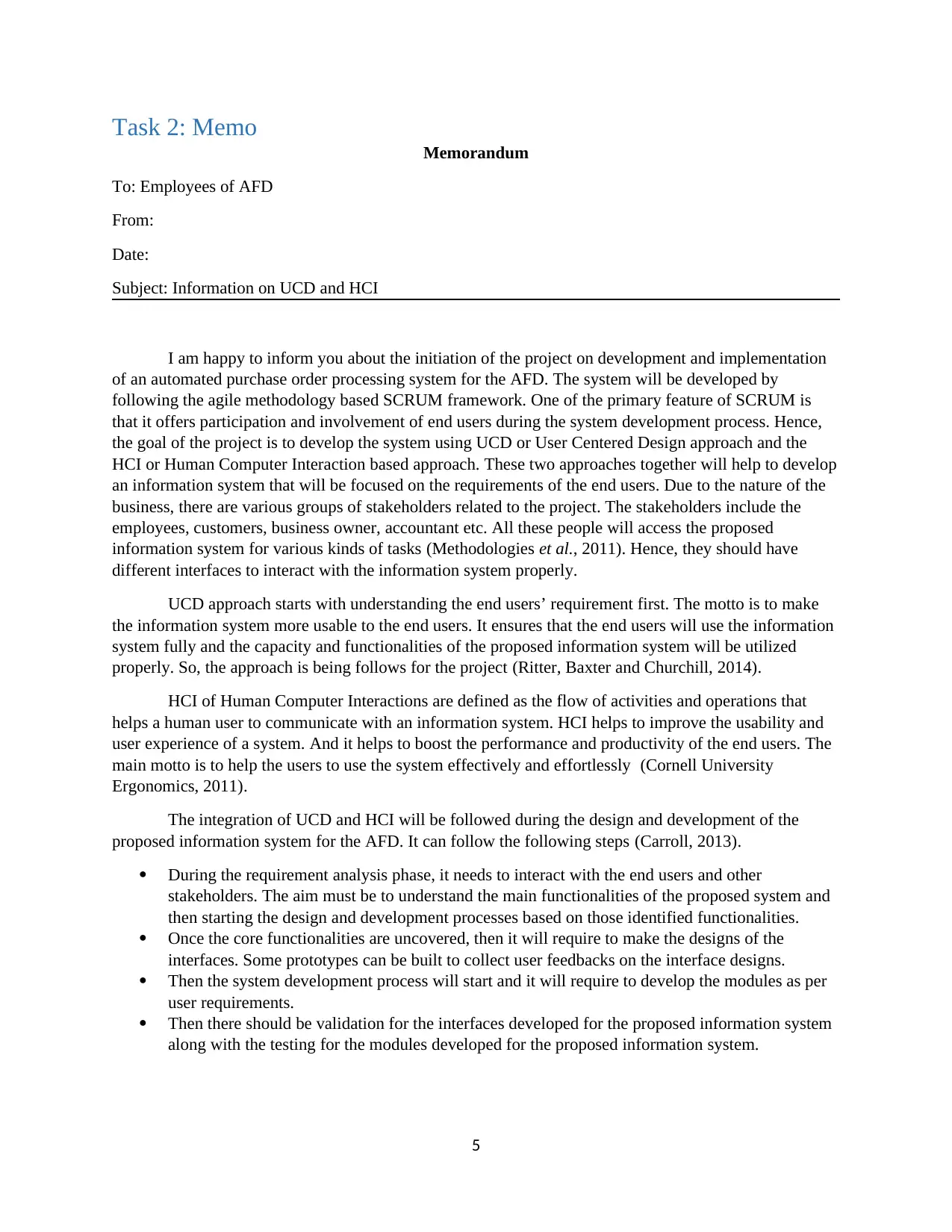
Task 2: Memo Memorandum
To: Employees of AFD
From:
Date:
Subject: Information on UCD and HCI
I am happy to inform you about the initiation of the project on development and implementation
of an automated purchase order processing system for the AFD. The system will be developed by
following the agile methodology based SCRUM framework. One of the primary feature of SCRUM is
that it offers participation and involvement of end users during the system development process. Hence,
the goal of the project is to develop the system using UCD or User Centered Design approach and the
HCI or Human Computer Interaction based approach. These two approaches together will help to develop
an information system that will be focused on the requirements of the end users. Due to the nature of the
business, there are various groups of stakeholders related to the project. The stakeholders include the
employees, customers, business owner, accountant etc. All these people will access the proposed
information system for various kinds of tasks (Methodologies et al., 2011). Hence, they should have
different interfaces to interact with the information system properly.
UCD approach starts with understanding the end users’ requirement first. The motto is to make
the information system more usable to the end users. It ensures that the end users will use the information
system fully and the capacity and functionalities of the proposed information system will be utilized
properly. So, the approach is being follows for the project (Ritter, Baxter and Churchill, 2014).
HCI of Human Computer Interactions are defined as the flow of activities and operations that
helps a human user to communicate with an information system. HCI helps to improve the usability and
user experience of a system. And it helps to boost the performance and productivity of the end users. The
main motto is to help the users to use the system effectively and effortlessly (Cornell University
Ergonomics, 2011).
The integration of UCD and HCI will be followed during the design and development of the
proposed information system for the AFD. It can follow the following steps (Carroll, 2013).
During the requirement analysis phase, it needs to interact with the end users and other
stakeholders. The aim must be to understand the main functionalities of the proposed system and
then starting the design and development processes based on those identified functionalities.
Once the core functionalities are uncovered, then it will require to make the designs of the
interfaces. Some prototypes can be built to collect user feedbacks on the interface designs.
Then the system development process will start and it will require to develop the modules as per
user requirements.
Then there should be validation for the interfaces developed for the proposed information system
along with the testing for the modules developed for the proposed information system.
5
To: Employees of AFD
From:
Date:
Subject: Information on UCD and HCI
I am happy to inform you about the initiation of the project on development and implementation
of an automated purchase order processing system for the AFD. The system will be developed by
following the agile methodology based SCRUM framework. One of the primary feature of SCRUM is
that it offers participation and involvement of end users during the system development process. Hence,
the goal of the project is to develop the system using UCD or User Centered Design approach and the
HCI or Human Computer Interaction based approach. These two approaches together will help to develop
an information system that will be focused on the requirements of the end users. Due to the nature of the
business, there are various groups of stakeholders related to the project. The stakeholders include the
employees, customers, business owner, accountant etc. All these people will access the proposed
information system for various kinds of tasks (Methodologies et al., 2011). Hence, they should have
different interfaces to interact with the information system properly.
UCD approach starts with understanding the end users’ requirement first. The motto is to make
the information system more usable to the end users. It ensures that the end users will use the information
system fully and the capacity and functionalities of the proposed information system will be utilized
properly. So, the approach is being follows for the project (Ritter, Baxter and Churchill, 2014).
HCI of Human Computer Interactions are defined as the flow of activities and operations that
helps a human user to communicate with an information system. HCI helps to improve the usability and
user experience of a system. And it helps to boost the performance and productivity of the end users. The
main motto is to help the users to use the system effectively and effortlessly (Cornell University
Ergonomics, 2011).
The integration of UCD and HCI will be followed during the design and development of the
proposed information system for the AFD. It can follow the following steps (Carroll, 2013).
During the requirement analysis phase, it needs to interact with the end users and other
stakeholders. The aim must be to understand the main functionalities of the proposed system and
then starting the design and development processes based on those identified functionalities.
Once the core functionalities are uncovered, then it will require to make the designs of the
interfaces. Some prototypes can be built to collect user feedbacks on the interface designs.
Then the system development process will start and it will require to develop the modules as per
user requirements.
Then there should be validation for the interfaces developed for the proposed information system
along with the testing for the modules developed for the proposed information system.
5
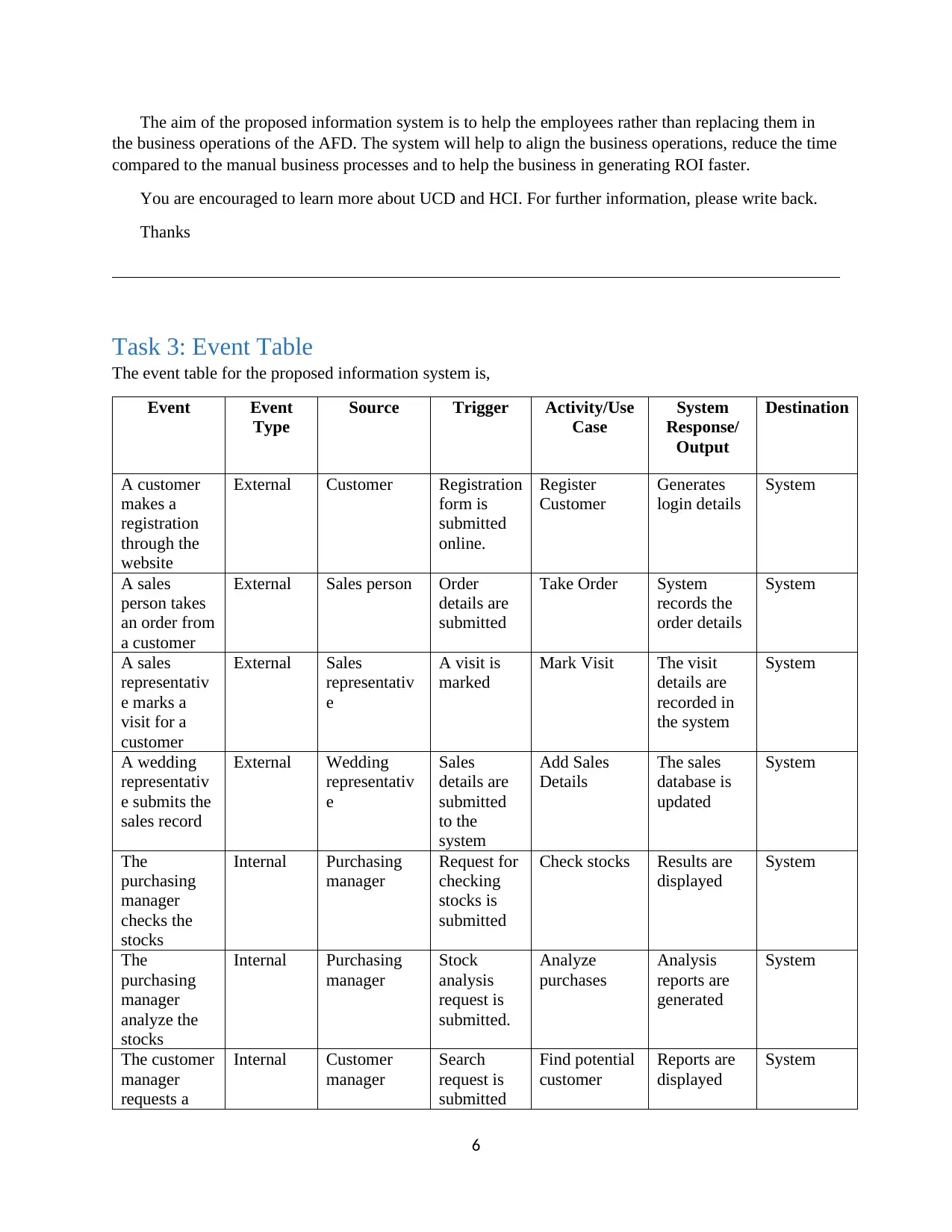
The aim of the proposed information system is to help the employees rather than replacing them in
the business operations of the AFD. The system will help to align the business operations, reduce the time
compared to the manual business processes and to help the business in generating ROI faster.
You are encouraged to learn more about UCD and HCI. For further information, please write back.
Thanks
Task 3: Event Table
The event table for the proposed information system is,
Event Event
Type
Source Trigger Activity/Use
Case
System
Response/
Output
Destination
A customer
makes a
registration
through the
website
External Customer Registration
form is
submitted
online.
Register
Customer
Generates
login details
System
A sales
person takes
an order from
a customer
External Sales person Order
details are
submitted
Take Order System
records the
order details
System
A sales
representativ
e marks a
visit for a
customer
External Sales
representativ
e
A visit is
marked
Mark Visit The visit
details are
recorded in
the system
System
A wedding
representativ
e submits the
sales record
External Wedding
representativ
e
Sales
details are
submitted
to the
system
Add Sales
Details
The sales
database is
updated
System
The
purchasing
manager
checks the
stocks
Internal Purchasing
manager
Request for
checking
stocks is
submitted
Check stocks Results are
displayed
System
The
purchasing
manager
analyze the
stocks
Internal Purchasing
manager
Stock
analysis
request is
submitted.
Analyze
purchases
Analysis
reports are
generated
System
The customer
manager
requests a
Internal Customer
manager
Search
request is
submitted
Find potential
customer
Reports are
displayed
System
6
the business operations of the AFD. The system will help to align the business operations, reduce the time
compared to the manual business processes and to help the business in generating ROI faster.
You are encouraged to learn more about UCD and HCI. For further information, please write back.
Thanks
Task 3: Event Table
The event table for the proposed information system is,
Event Event
Type
Source Trigger Activity/Use
Case
System
Response/
Output
Destination
A customer
makes a
registration
through the
website
External Customer Registration
form is
submitted
online.
Register
Customer
Generates
login details
System
A sales
person takes
an order from
a customer
External Sales person Order
details are
submitted
Take Order System
records the
order details
System
A sales
representativ
e marks a
visit for a
customer
External Sales
representativ
e
A visit is
marked
Mark Visit The visit
details are
recorded in
the system
System
A wedding
representativ
e submits the
sales record
External Wedding
representativ
e
Sales
details are
submitted
to the
system
Add Sales
Details
The sales
database is
updated
System
The
purchasing
manager
checks the
stocks
Internal Purchasing
manager
Request for
checking
stocks is
submitted
Check stocks Results are
displayed
System
The
purchasing
manager
analyze the
stocks
Internal Purchasing
manager
Stock
analysis
request is
submitted.
Analyze
purchases
Analysis
reports are
generated
System
The customer
manager
requests a
Internal Customer
manager
Search
request is
submitted
Find potential
customer
Reports are
displayed
System
6
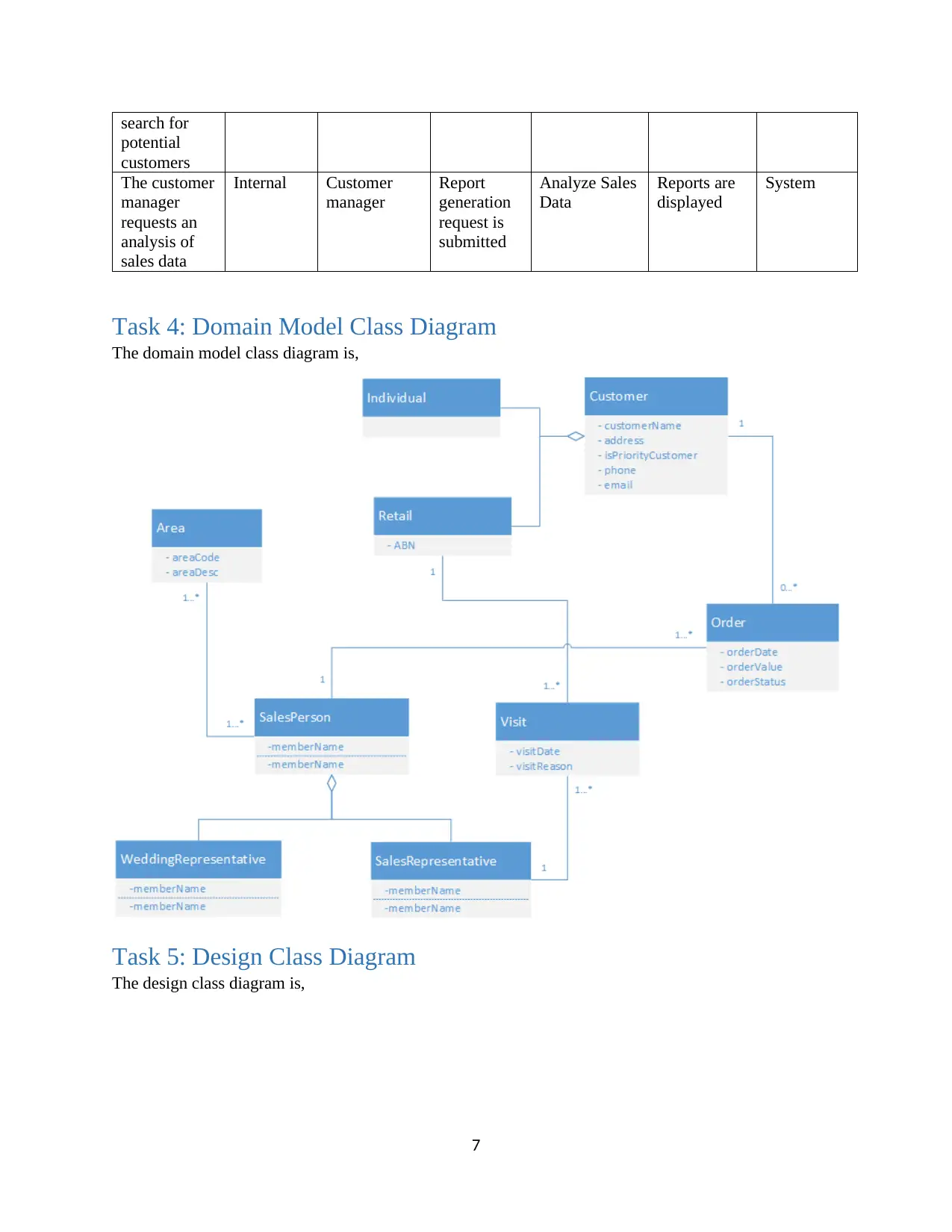
search for
potential
customers
The customer
manager
requests an
analysis of
sales data
Internal Customer
manager
Report
generation
request is
submitted
Analyze Sales
Data
Reports are
displayed
System
Task 4: Domain Model Class Diagram
The domain model class diagram is,
Task 5: Design Class Diagram
The design class diagram is,
7
potential
customers
The customer
manager
requests an
analysis of
sales data
Internal Customer
manager
Report
generation
request is
submitted
Analyze Sales
Data
Reports are
displayed
System
Task 4: Domain Model Class Diagram
The domain model class diagram is,
Task 5: Design Class Diagram
The design class diagram is,
7
Paraphrase This Document
Need a fresh take? Get an instant paraphrase of this document with our AI Paraphraser
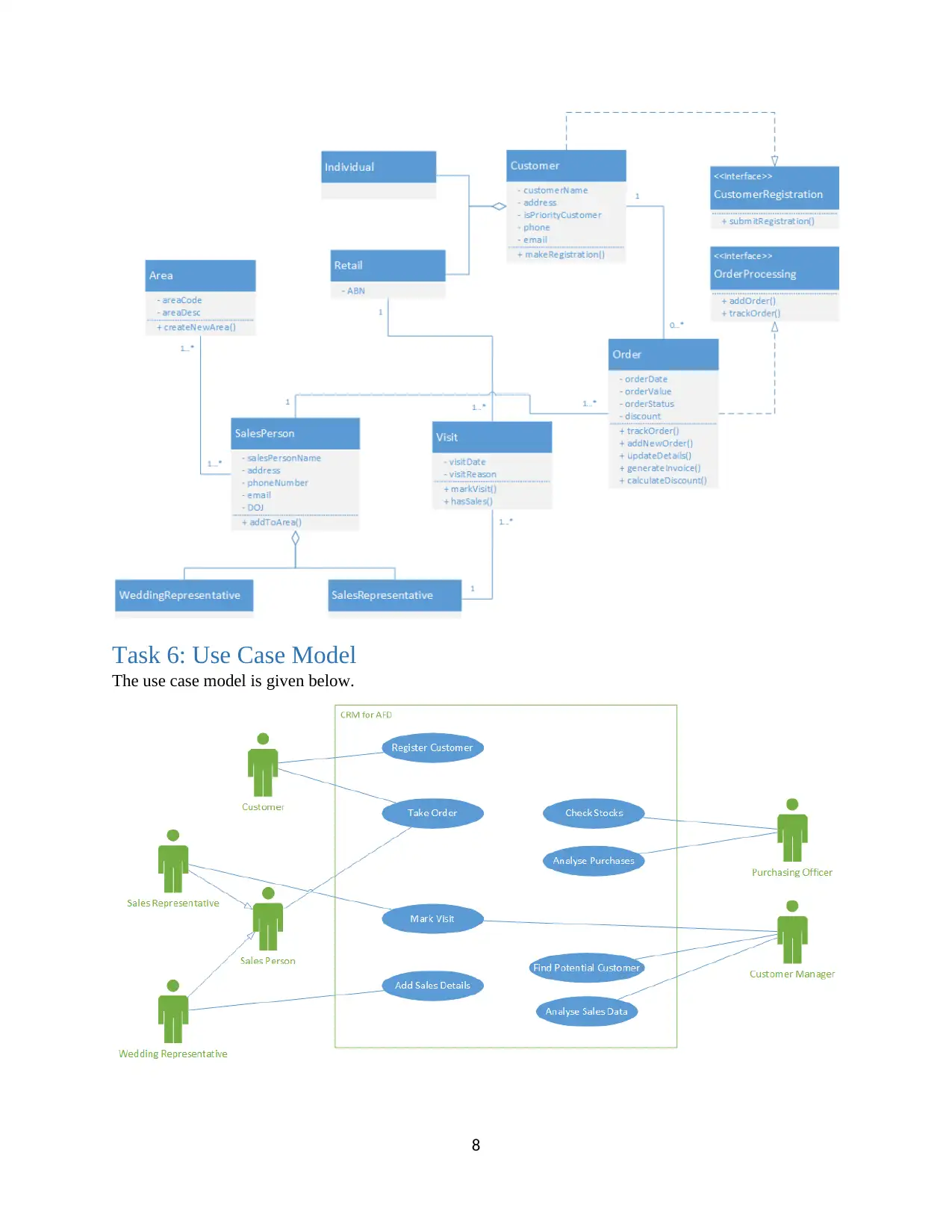
Task 6: Use Case Model
The use case model is given below.
8
The use case model is given below.
8

Task 7: Use Case Description
Main Flow
- Sales person checks the availability of the products according to the requirements of a
customer
- Then the sales person negotiate a discounted deal with the customer.
- Customer places an order through a sales person.
- Sales person adds the details to the system
- The system records the details of the order
- The system sends the order to the order processing team
- It generates a reference for the order and forwards the same to the sales person and to the
customer
- System updates the status of the order as processing.
Alternative Flow
- The sales person finds that no deal is possible with a customer
- The sales person notes the requirements and forwards the same to the customer manager
- The customer management department then tries to negotiate a deal with the customer.
9
Main Flow
- Sales person checks the availability of the products according to the requirements of a
customer
- Then the sales person negotiate a discounted deal with the customer.
- Customer places an order through a sales person.
- Sales person adds the details to the system
- The system records the details of the order
- The system sends the order to the order processing team
- It generates a reference for the order and forwards the same to the sales person and to the
customer
- System updates the status of the order as processing.
Alternative Flow
- The sales person finds that no deal is possible with a customer
- The sales person notes the requirements and forwards the same to the customer manager
- The customer management department then tries to negotiate a deal with the customer.
9
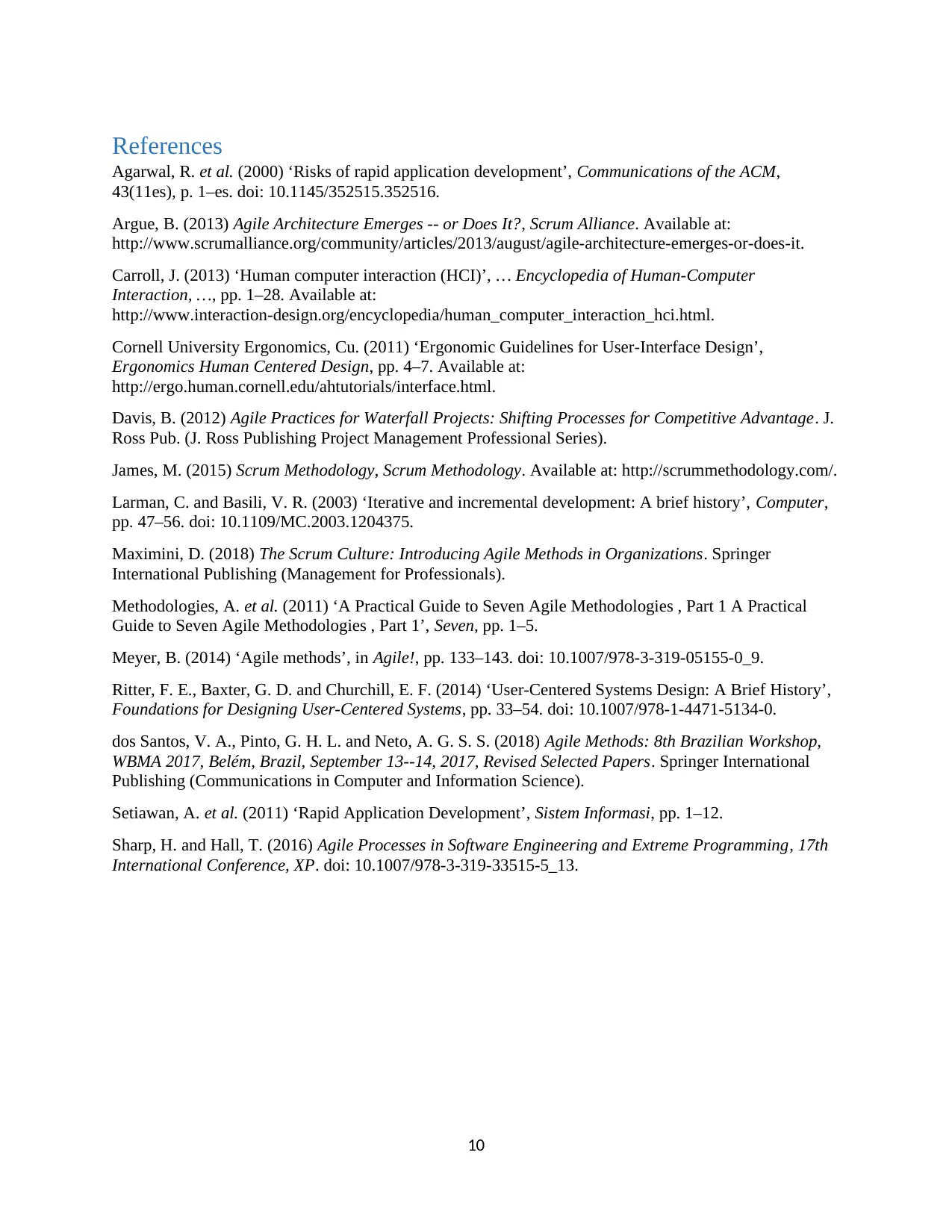
References
Agarwal, R. et al. (2000) ‘Risks of rapid application development’, Communications of the ACM,
43(11es), p. 1–es. doi: 10.1145/352515.352516.
Argue, B. (2013) Agile Architecture Emerges -- or Does It?, Scrum Alliance. Available at:
http://www.scrumalliance.org/community/articles/2013/august/agile-architecture-emerges-or-does-it.
Carroll, J. (2013) ‘Human computer interaction (HCI)’, … Encyclopedia of Human-Computer
Interaction, …, pp. 1–28. Available at:
http://www.interaction-design.org/encyclopedia/human_computer_interaction_hci.html.
Cornell University Ergonomics, Cu. (2011) ‘Ergonomic Guidelines for User-Interface Design’,
Ergonomics Human Centered Design, pp. 4–7. Available at:
http://ergo.human.cornell.edu/ahtutorials/interface.html.
Davis, B. (2012) Agile Practices for Waterfall Projects: Shifting Processes for Competitive Advantage. J.
Ross Pub. (J. Ross Publishing Project Management Professional Series).
James, M. (2015) Scrum Methodology, Scrum Methodology. Available at: http://scrummethodology.com/.
Larman, C. and Basili, V. R. (2003) ‘Iterative and incremental development: A brief history’, Computer,
pp. 47–56. doi: 10.1109/MC.2003.1204375.
Maximini, D. (2018) The Scrum Culture: Introducing Agile Methods in Organizations. Springer
International Publishing (Management for Professionals).
Methodologies, A. et al. (2011) ‘A Practical Guide to Seven Agile Methodologies , Part 1 A Practical
Guide to Seven Agile Methodologies , Part 1’, Seven, pp. 1–5.
Meyer, B. (2014) ‘Agile methods’, in Agile!, pp. 133–143. doi: 10.1007/978-3-319-05155-0_9.
Ritter, F. E., Baxter, G. D. and Churchill, E. F. (2014) ‘User-Centered Systems Design: A Brief History’,
Foundations for Designing User-Centered Systems, pp. 33–54. doi: 10.1007/978-1-4471-5134-0.
dos Santos, V. A., Pinto, G. H. L. and Neto, A. G. S. S. (2018) Agile Methods: 8th Brazilian Workshop,
WBMA 2017, Belém, Brazil, September 13--14, 2017, Revised Selected Papers. Springer International
Publishing (Communications in Computer and Information Science).
Setiawan, A. et al. (2011) ‘Rapid Application Development’, Sistem Informasi, pp. 1–12.
Sharp, H. and Hall, T. (2016) Agile Processes in Software Engineering and Extreme Programming, 17th
International Conference, XP. doi: 10.1007/978-3-319-33515-5_13.
10
Agarwal, R. et al. (2000) ‘Risks of rapid application development’, Communications of the ACM,
43(11es), p. 1–es. doi: 10.1145/352515.352516.
Argue, B. (2013) Agile Architecture Emerges -- or Does It?, Scrum Alliance. Available at:
http://www.scrumalliance.org/community/articles/2013/august/agile-architecture-emerges-or-does-it.
Carroll, J. (2013) ‘Human computer interaction (HCI)’, … Encyclopedia of Human-Computer
Interaction, …, pp. 1–28. Available at:
http://www.interaction-design.org/encyclopedia/human_computer_interaction_hci.html.
Cornell University Ergonomics, Cu. (2011) ‘Ergonomic Guidelines for User-Interface Design’,
Ergonomics Human Centered Design, pp. 4–7. Available at:
http://ergo.human.cornell.edu/ahtutorials/interface.html.
Davis, B. (2012) Agile Practices for Waterfall Projects: Shifting Processes for Competitive Advantage. J.
Ross Pub. (J. Ross Publishing Project Management Professional Series).
James, M. (2015) Scrum Methodology, Scrum Methodology. Available at: http://scrummethodology.com/.
Larman, C. and Basili, V. R. (2003) ‘Iterative and incremental development: A brief history’, Computer,
pp. 47–56. doi: 10.1109/MC.2003.1204375.
Maximini, D. (2018) The Scrum Culture: Introducing Agile Methods in Organizations. Springer
International Publishing (Management for Professionals).
Methodologies, A. et al. (2011) ‘A Practical Guide to Seven Agile Methodologies , Part 1 A Practical
Guide to Seven Agile Methodologies , Part 1’, Seven, pp. 1–5.
Meyer, B. (2014) ‘Agile methods’, in Agile!, pp. 133–143. doi: 10.1007/978-3-319-05155-0_9.
Ritter, F. E., Baxter, G. D. and Churchill, E. F. (2014) ‘User-Centered Systems Design: A Brief History’,
Foundations for Designing User-Centered Systems, pp. 33–54. doi: 10.1007/978-1-4471-5134-0.
dos Santos, V. A., Pinto, G. H. L. and Neto, A. G. S. S. (2018) Agile Methods: 8th Brazilian Workshop,
WBMA 2017, Belém, Brazil, September 13--14, 2017, Revised Selected Papers. Springer International
Publishing (Communications in Computer and Information Science).
Setiawan, A. et al. (2011) ‘Rapid Application Development’, Sistem Informasi, pp. 1–12.
Sharp, H. and Hall, T. (2016) Agile Processes in Software Engineering and Extreme Programming, 17th
International Conference, XP. doi: 10.1007/978-3-319-33515-5_13.
10
1 out of 10
Related Documents
Your All-in-One AI-Powered Toolkit for Academic Success.
+13062052269
info@desklib.com
Available 24*7 on WhatsApp / Email
![[object Object]](/_next/static/media/star-bottom.7253800d.svg)
Unlock your academic potential
© 2024 | Zucol Services PVT LTD | All rights reserved.





